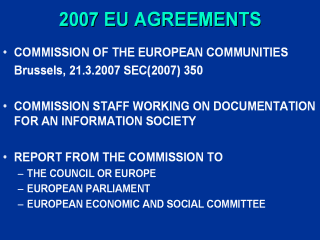| front |1 |2 |3 |4 |5 |6 |7 |8 |9 |10 |11 |12 |13 |14 |15 |16 |17 |18 |19 |20 |21 |22 |23 |24 |25 |26 |27 |28 |29 |30 |31 |32 |33 |34 |35 |36 |37 |38 |39 |review |
 |
ANNEX 8 BRIEF DESCRIPTION OF THE NOTIFICATION
PROCEDURE This annex gives a general overview of the notification procedure for products and indicates the specific procedural characteristics that apply to Information Society services. For a more detailed description of the procedure, please refer to the information brochure Guide to the procedure for the provision of information in the field of technical standards and regulations and of rules on Information Society services, available on the following website: http://ec.europa.eu/enterprise/tris. Legal bases Introduced in 1984 by Directive 83/189/EEC1, the notification procedure in the field of technical regulations has gradually been extended to all industrial, agricultural and fishery products. In 1998, Directive 83/189/EEC was repealed and codified by Directive 98/34/EC2, which in turn was amended by Directive 98/48/EC3 in order to extend the notification procedure to Information Society services, with the adaptations needed to take account of the demands of the sector. Obligation to notify and the standstill period Article 8(1) of the Directive stipulates that the Member States shall inform the Commission of any draft technical regulation prior to its adoption. The simple transposition of a Community act does not require prior notification, unless the national authorities adopt national provisions that go beyond mere compliance with Community acts and that contain technical regulations within the meaning of the Directive (Article 10). Starting from the date of notification of the draft, a three-month standstill period – during which the notifying Member State cannot adopt the technical regulation in question – enables the Commission and the other Member States to examine the notified text and to respond appropriately. The only derogation to this rule is linked to the nature of the measure in question: for technical specifications linked to fiscal or financial measures, there is no standstill period. This also applies to technical regulations that have to be adopted urgently (see below). Possible reactions and consequences Where it emerges that the notified drafts are liable to create barriers to the free movement of goods or to the free provision of Information Society services (Articles 28-30, 43 and 49 of the EC Treaty) or to secondary legislation, the Commission and the other Member States submit a detailed opinion to the Member State that has prepared the draft (Article 9(2) of the Directive). The detailed opinion has the effect of extending the standstill period by an additional three months. The Commission and the Member States can also make comments about a notified draft that appears to comply with Community law but that requires clarifications in its interpretation (Article 8(2)). The Commission can also block a draft for a underway in the same field (Article 9(3) to (5)). In the event of a detailed opinion being issued, the Member State concerned informs the Commission of the action that it intends to take in response to the detailed opinion, and the Commission comments on that reaction (Article 9(2)). With regard to the comments, even though the Directive does not lay down any legal obligation for the Member State receiving the comments to indicate what follow-up action it intends to take, the Member States are inclined to respond, thus making the procedure a genuine instrument of dialogue. |